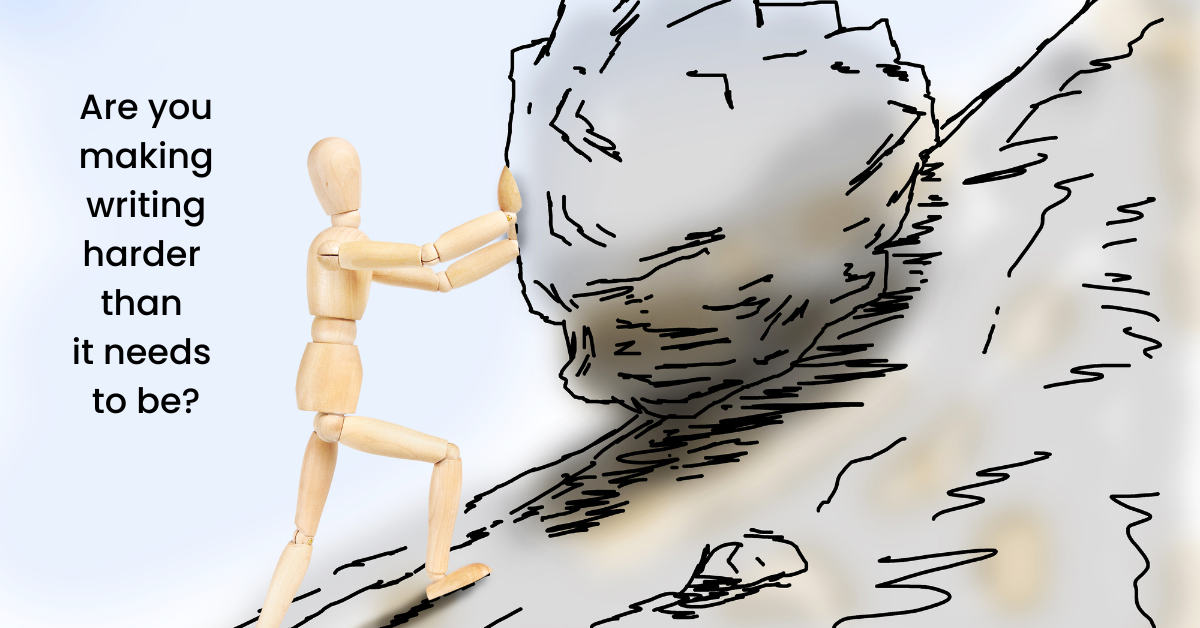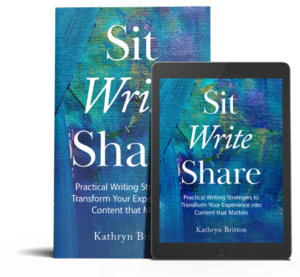Last night, I asked someone who really wants to write but hasn’t been getting it done, “Are you making writing harder than it needs to be?” She thought that summed up her situation, so we spent our time together exploring ways that she could make it easier.
Writing can be liberating and exhilarating, but not if you expect a polished piece to appear magically on the page in front of you.
Liberating and exhilarating?
Yes, because writing can help you connect with your thoughts, letting them wash over you and sort themselves out. Many people tell me that they gain tremendous insights into their own thinking by writing. But the thoughts need the freedom to swirl around in your head without being harshly evaluated. If you expect them to come out fully formed, you’ll be disappointed as you look at the page in front of you. Disappointment will make your ideas back off.
There’s a wonderful picture book, Play With Me by Marie Hall Ets about a little girl trying to get a grasshopper, a chipmunk, a blue jay, a frog, a turtle, and a snake to play with her. They all run away until she sits still and lets them approach her. Your thoughts may need you to hold still so that they can emerge without you frightening them off. In writing, this means turning off your internal editor until you have an initial draft.
What can you do when writing seems both desirable and hard? Here are some things to try as you work to liberate your writing voice.
Do You Prefer a Top-Down or Bottom-Up Approach?
As I was working on the list in the next section, I mused on how differently people approach writing. Some are insistent that a full outline is the first step. They follow an approach I call top-down based on my computer science experience. Others start writing and let the structure emerge from what comes out, a bottom-up approach.
If you want an entire outline before you get started (top-down), that’s fine unless you are so attached to your outline that you get derailed when something in it doesn’t work. If you just start writing to see what emerges (bottom-up), eventually you’ll need to examine what comes out to determine some kind of structure to help your reader navigate what you write.
As you write more, you may find you go back and forth between top-down and bottom-up approaches multiple times. When you are stuck, try switching to the other approach.
Other Suggestions for Making Writing Easier
Some of these suggestions are described in more detail in Sit Write Share or my blog.
- Try writing with pen and paper instead of keyboard. This client had an aha moment when she thought of writing with her orange pen. I noticed a major uptick in the energy in her voice when she called herself “Orange-Pen Latondra” (not her real name).
- Try dictation. If first drafts are murderously difficult for you but you know you can explain your ideas to a friend, imagine that friend sitting in front of you while you speak into a speech-to-text program, such as google docs or Word. The goal is to get a first draft that can be polished, not a final product. (See Write Experiment 14: Try Speech-to-Text.)
- Keep a list of stories that you could tell about topics that are important to you. If you have that list, the next time you sit down to write, you’ll have the option of picking from the list to relate. When you do, just write the story without worrying about all the text that might surround it. (See Write Experiment 5: Collect Story Seeds.)
- Write about not being able to write. What does it feel like in your body? Perhaps you will encounter what is blocking your thinking. When you bring the block into focus, you may see a creative way around it. (See Write Experiment 10: Write About Not Being Able to Write.)
- Write what’s on your mind right now. Just listen to the swirl of thoughts in your head. This is similar to morning pages described in The Artist’s Way, except that I suggest you look at what comes out with an eye toward what you could use later. Are there story seeds in your writing? Important concepts that you want to work out? (See my blog posts, Write Whatever is On Your Mind and A Repeatable Structure in Action.)
- Pick a concept and explain it without worrying about transitions or overall structure of your chapter or article. Later, this explanation might serve like a pearl on a necklace, part of the beauty of the whole. (See Write Experiment 6: Mine Stories for Concepts)
- Use an entire writing session to brainstorm what you want to write about. Brainstorming involves collecting ideas without judging or rejecting them. If you collected them on post-it notes, you could stick them to a wall or whiteboard and then play around with organization, trying out different clumps. You could also pull a post-it off the board as the prompt for your next writing session. (See Write Experiment 2: Play with Ideas.)
- Sort through previous pieces of writing to see which might be or contain pearls that could be strung together into something new. Sometimes this involves repurposing old writing for a new audience. (See Write Experiment7: Repurpose Old Writing.)
- Commit yourself to deadlines that will be noticed by other people. One way to do that is to join a writers’ workshop where you are expected to contribute periodically. It can help to have outside expectations. (See Share Experiment 6: Find a Good Writers’ Workshop.)
Make Writing Just a Little Bit Easier
Doing hard things can be incredibly satisfying if and only if you do them. Any of these approaches might help you make writing just enough easier that you can get it done. When you finish a draft or a polished piece, take the time to bask in the completion of something valuable but hard.

